SRAM GX Eagle Drivetrain
Total Measured Weight of Groupset: 1,870 grams
Components:
- 10-50 XG-1275 Eagle Cassette
- 12-Speed GX Eagle Rear Derailleur
- GX Eagle Trigger Shifter
- GX Eagle Crankset
- GX Eagle Chain
MSRP: $527
Duration of Test: ~1000 miles (so far)
Mounted to: Santa Cruz Hightower
Test Locations: In and around Whitefish, Montana
Reviewer: 5’9” 150 lbs.
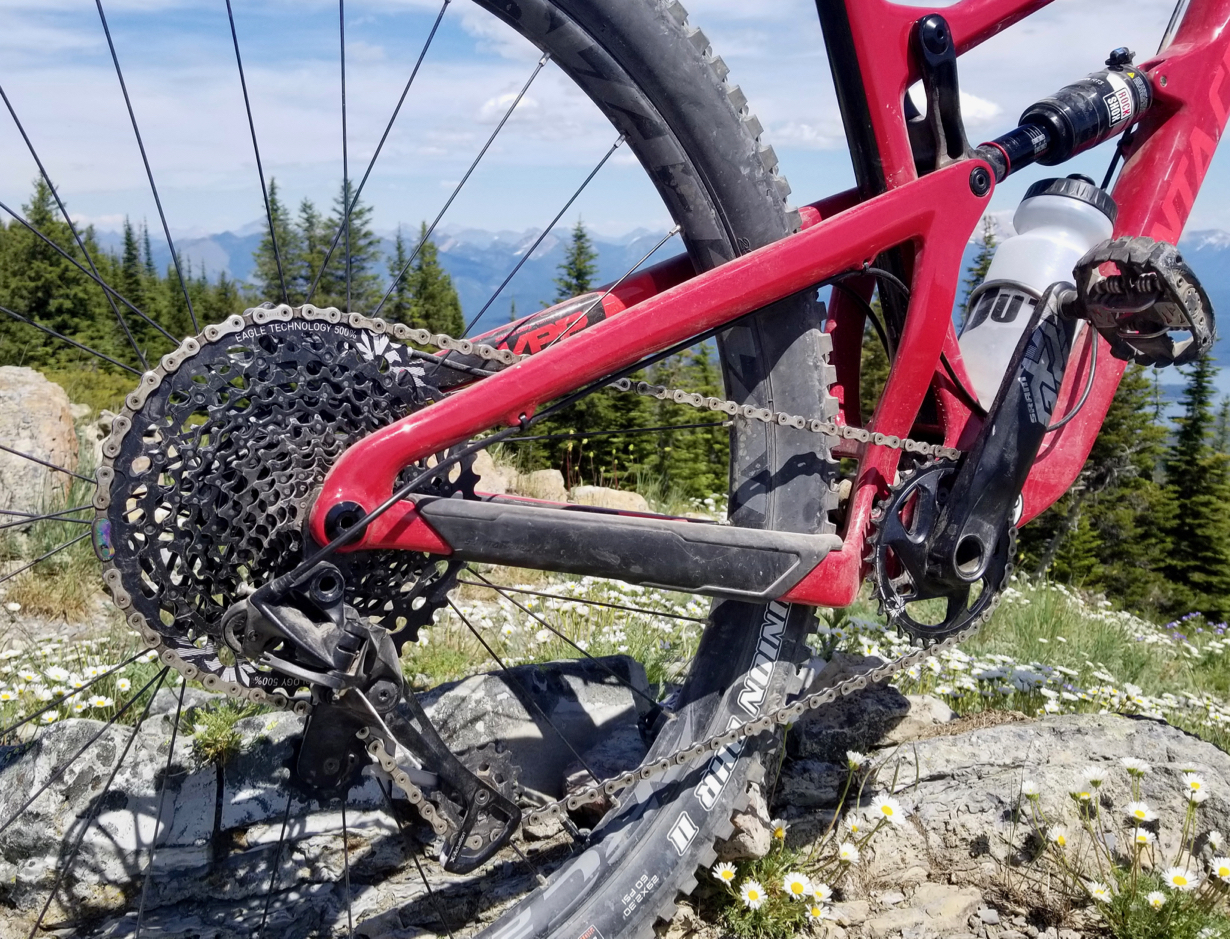
Intro
A year or two ago, Sram declared that the front derailleur was dead. “1x” drivetrains had become increasingly common, and improvements in chain retention, gearing range, and affordability were all ushering in the era of single-ring ubiquity.
But while I’ve been (quite happily) running 1x drivetrains for a while now, there were still some legitimate arguments for keeping two chainrings and a front derailleur, and the most compelling was probably that 11-speed drivetrains didn’t quite have the gear range that some rides required.
But then Sram introduced the XX1 and X01 Eagle drivetrains, which significantly expanded the gearing range available on a 1x setup. And while those drivetrains work extraordinarily well, at over $1200 USD for the less expensive X01 kit, they are also priced at a level that confines them to upper-tier bikes.
Enter the GX Eagle group. It has all of the range of the other Eagle drivetrains, but at a fraction of the cost; MSRP is $527 USD.
So it’s this new GX Eagle group that has the most potential to put the final nail in the coffin of the front derailleur.
Sram released the GX Eagle group a few weeks ago, and we’ve been putting miles on it and getting real-world weights. So it’ll be a little while before we have firm conclusions about durability and longevity, but in the meantime, here are our initial impressions after ten rides.

What’s New & Different
The GX Eagle follows in the footsteps of the top-of-the-line XX1 Eagle drivetrain and the (still very high end) X01 Eagle drivetrains — it’s a 1x drivetrain with a 12-speed cassette cluster. And like the upper-tier Eagle groups, GX Eagle retains the 10-tooth to 50-tooth range on the cassette.
With an X01 Eagle group in one hand and the GX Eagle group in the other, here are the obvious differences between the two:
Derailleur
The X01 Eagle and GX Eagle derailleurs are remarkably similar. The X01 derailleur has nicer hardware, and some aluminum fasteners where the GX Eagle gets steel.
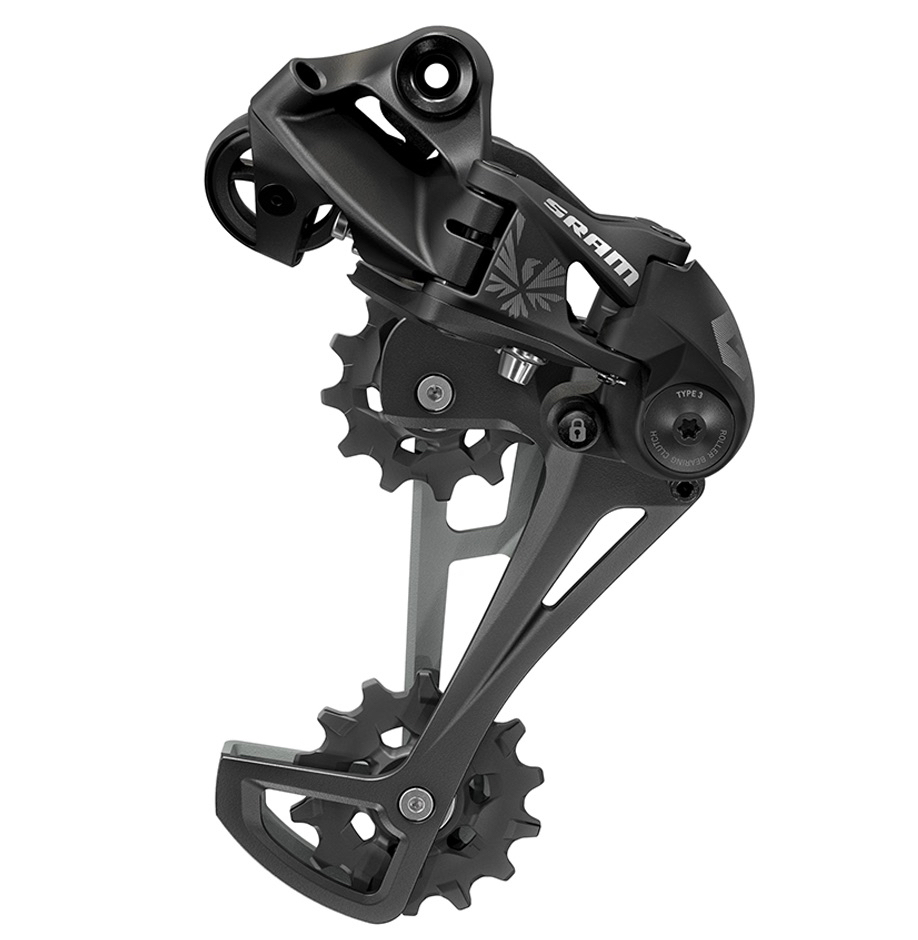
Both the X01 and GX Eagle get the new Type 3 roller bearing clutch, and both have revisions around the mounting bolt and B-set plate to (a) increase durability and (b) resolve the issue of derailleurs loosening themselves, which was pretty common on Sram’s 11-speed drivetrains.
Between the GX and X01 Eagle derailleurs, I don’t see any big functional differences, but the X01 Eagle derailleur weighs a bit less.
Shifter
The X01 Eagle shifter has nicer, metal fittings, whereas the GX Eagle has more plastic. The angle of the X01 Eagle’s downshift lever can be adjusted, whereas the GX Eagle’s levers are in a fixed position.
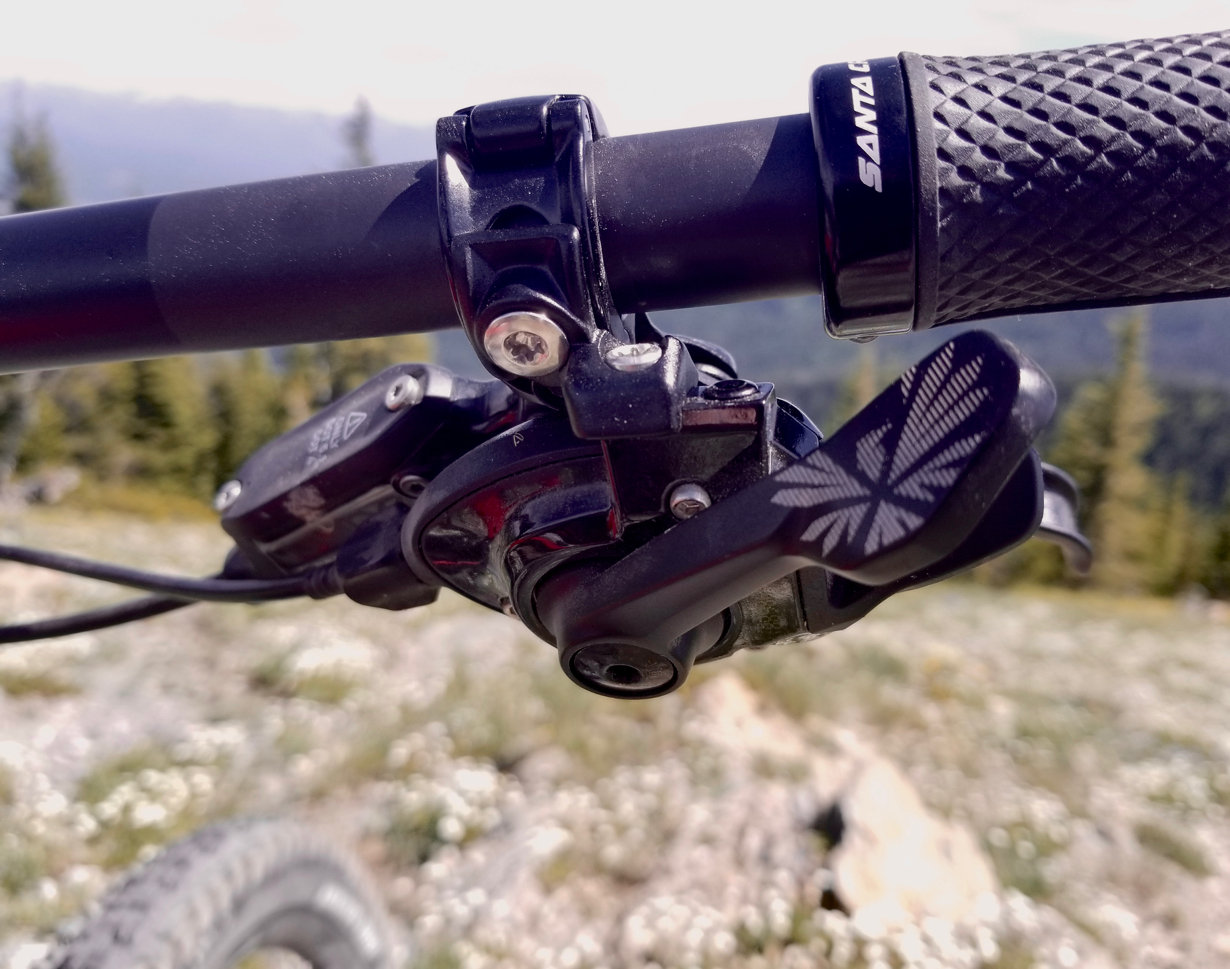
Internally, they both have Sram’s “Zero Loss” feature, which basically means there’s no slop in the shift lever — any movement of the lever results in movement of the cable. They also both use Sram’s MatchMaker X mounting system, so they play nicely with Sram brakes.
Cassette
The cassette is perhaps the biggest difference between the groups, with the X01 Eagle cassette using Sram’s “X-Dome” technology, which the machining nerd in me thinks is pretty much the coolest thing ever. For the X01 Eagle, the top 11 cogs are machined out of a single piece of steel, then pinned to the aluminum 50-tooth cog.
For the GX Eagle cassette, the top 11 cogs are stamped steel that are pinned together, with the 50-tooth cog still being pinned aluminum:
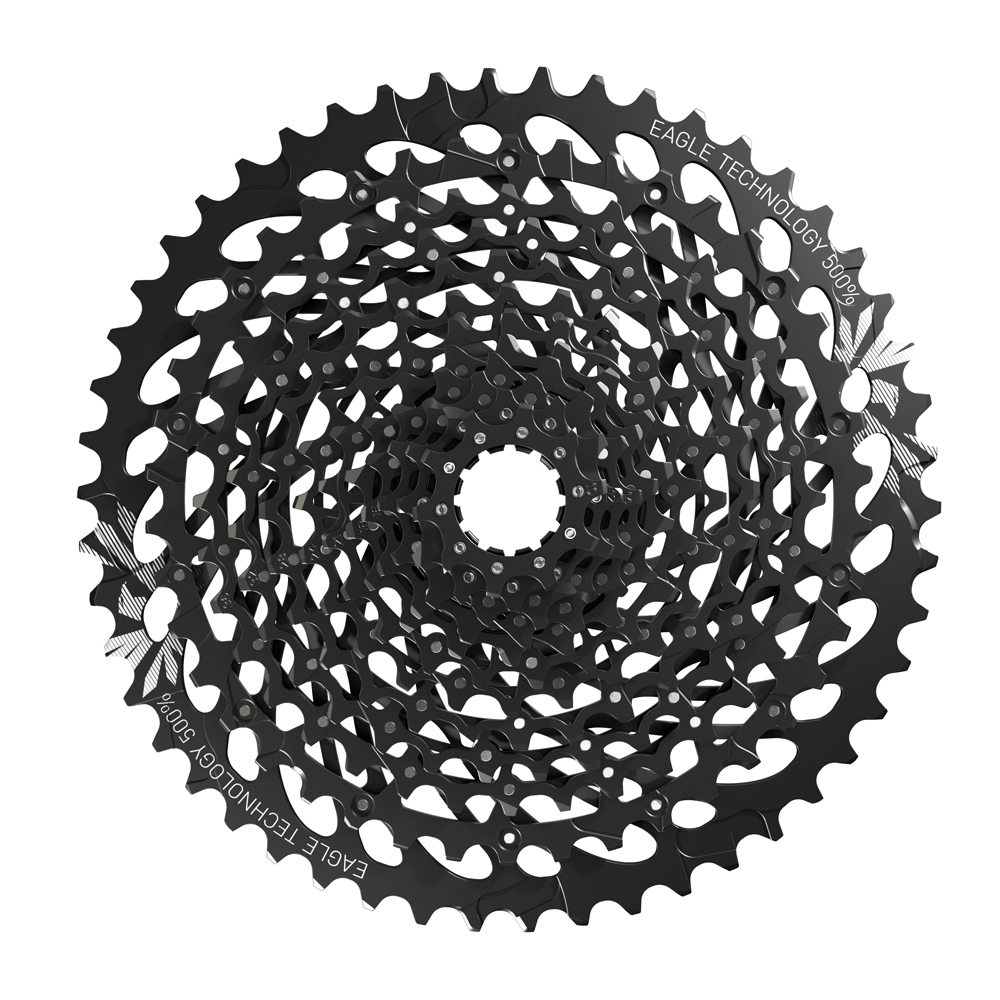
The real world difference between the X01 Eagle and GX Eagle cassettes is mostly weight savings, although the X01 cassette probably sheds mud a little better.
Cranks
The cranks are another spot with a big and fairly obvious difference. In short, X01 Eagle has carbon cranks, and GX Eagle has aluminum cranks.
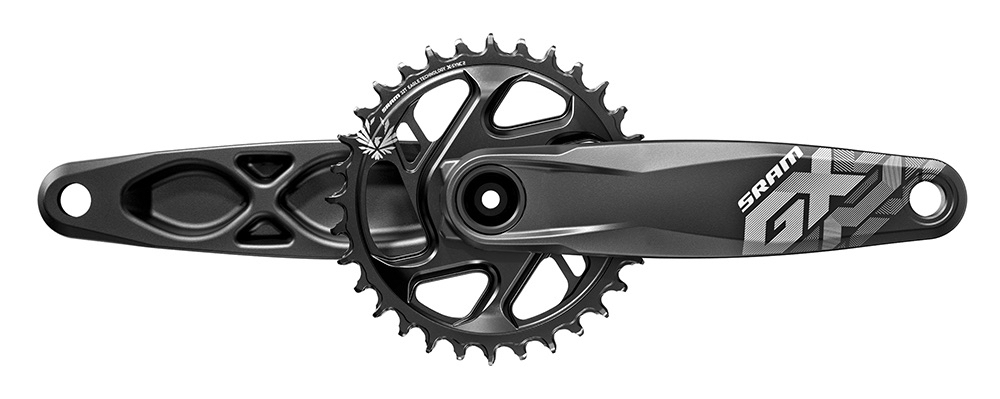
The chainrings that are attached to those cranks are a bit different too, with the X01 Eagle ring being a bit more nicely machined, and the GX Eagle ring looking a bit more stamped and less refined.
Both rings, however, have the X-Sync 2 tooth profile, which is both narrow / wide and “wavy” (for lack of a better term). That wavy pattern is supposed to help with chain retention, while also improving how the teeth wear. Older narrow/wide rings were prone to get a bit noisy as they wore, so I’ll be watching this ring to see how it holds up.
But as for the crankset, the real-world difference between the X01 Eagle and GX Eagle is mostly weight. There may be a difference in stiffness, but if there is, it’s not immediately apparent from my time riding each setup.
Chain
The X01 Eagle chain is fully chrome plated (inner and outer links), and the pins are hollow. The GX Eagle only gets chrome plated outer links, and the pins are solid. So there’s a bit of extra weight from the solid pins on the GX Eagle chain, and the X01 chain potentially holds up and shifts a bit better.
All of the Eagle chains are the result of some new manufacturing techniques from Sram that, among other things, means the pins don’t protrude past the links at all (which keeps the chain narrower).
Gear Range
At the risk of stating the obvious, the whole point of the Eagle line of drivetrains is to get a wide gear range with a single front chainring. A bigger gear range means that you get an easier low gear and a harder top gear, all without the fuss of a front derailleur.
Frequently, you’ll see the gear range expressed as a percentage — GX Eagle has a 500% gear range (which you won’t forget, since it’s printed in big letters on the cassette). There’s a 500% difference between the smallest cog (10 teeth) and the biggest cog (50 teeth). Sram 11-speed drivetrains have a 420% gear range, and a Shimano XT 11-46 cassette has a 418% gear range.
Those ranges are all just talking about single chainring setups, but the interesting thing about Eagle drivetrains (including GX Eagle) is that, for the first time, the gear range legitimately competes with a double chainring setup. And the best way to assess that is to look at gear-inch ratios.
Simply put, a gear inch ratio is how many inches the bike moves forward with a single revolution of the cranks in a given gear. So if you take one full pedal stroke, it’s how far the bike is going to travel (without coasting).
For your easy gear, a smaller number means that the gear is easier. You’re traveling less distance for every pedal stroke, which means the gearing is really low. For your hard gear, it’s just the opposite – the higher the number, the farther you’ll go on one pedal stroke, which means that the gear is harder.
Let’s look at four potential drivetrain setups that are realistic examples:
(1) The GX Eagle drivetrain with a 34-tooth chainring, and a 10-50 cassette.
(2) A Sram X1 11-speed drivetrain with a 30-tooth chainring and a 10-42 cassette.
(3) A Shimano XT 11-speed drivetrain with a 32-tooth chainring and an 11-46 cassette
(4) A Shimano XT 10-speed drivetrain with double chainring (24 / 36 tooth) setup and an 11-36 cassette.
For each of those, let’s look at the easiest gear and the hardest gear the drivetrain offers, expressed in gear inches. Remember, a smaller number means the easiest gear is easier, and a bigger number means the hardest gear is harder.
For reference, these numbers are calculated on a 27.5” wheel, with a 2.35” tire:
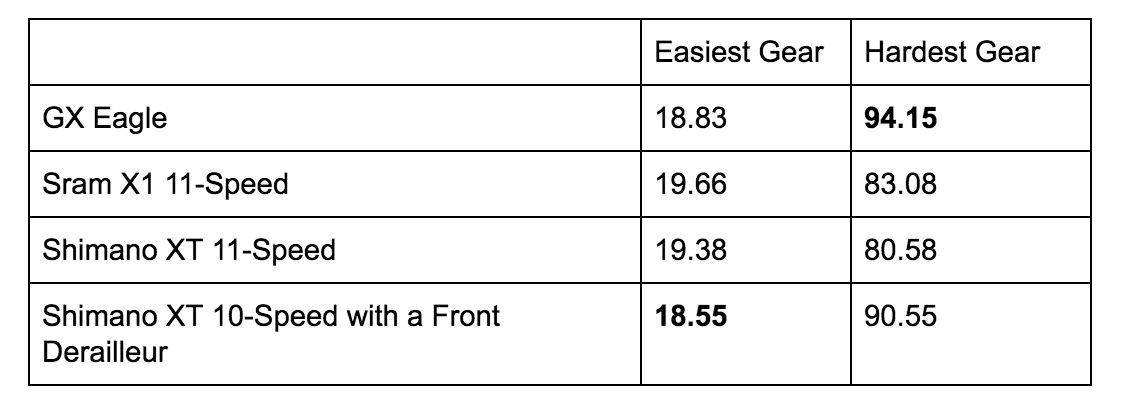
So what’s the takeaway here? The 10-speed drivetrain with a front derailleur has the easiest gear by a tiny margin — it beats out GX Eagle by .28 inches. But GX Eagle has the hardest gear by a significant amount. And when comparing the GX Eagle drivetrain to the 11-speed drivetrains, it isn’t really even close; GX Eagle has an easier low gear, and a harder high gear by significant margins.
Now all of these configurations can be made easier (or harder) by changing the chainring sizes. By going down to a 32-tooth chainring, the GX Eagle drivetrain would have the easiest gear of the bunch by a fair margin, but the hardest gear wouldn’t quite match the hardest gear of the XT drivetrain with a front derailleur. But the range remains the same, so it just becomes a question of whether you want to scoot that range toward easier gears or harder gears.
Weights
For GX Eagle and X01 Eagle, these are our own measured weights. For Shimano XT, these are stated weights:
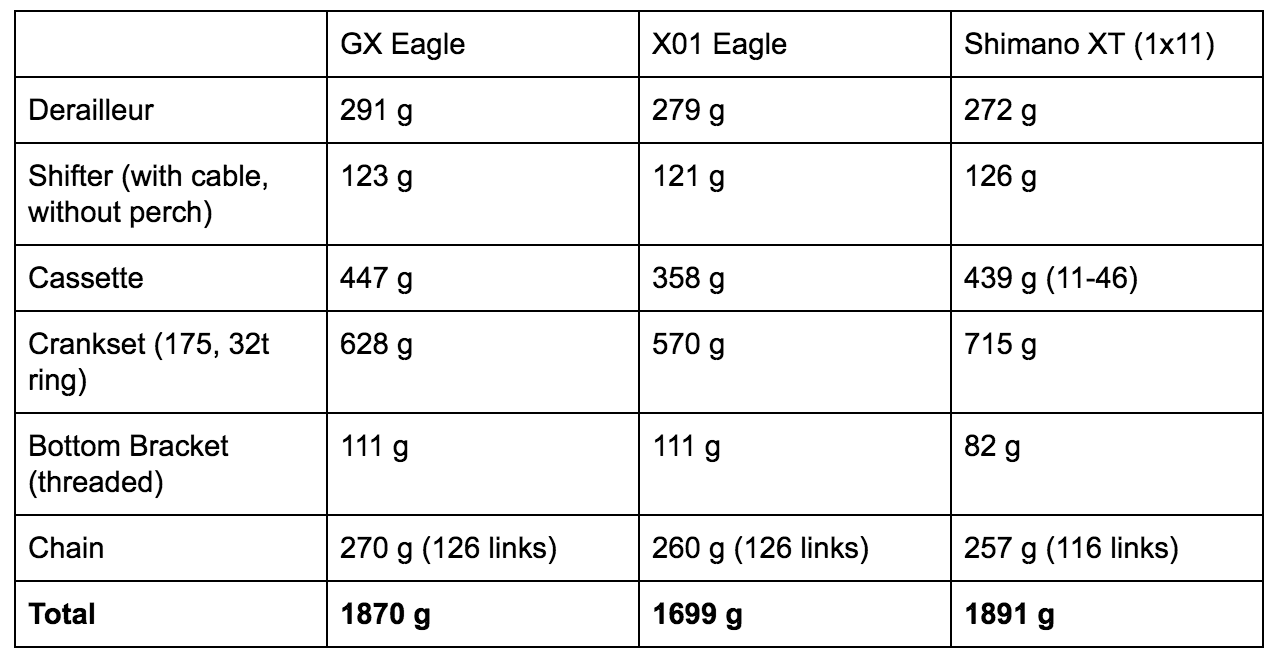
The most noteworthy thing here is that GX Eagle is about the same weight as an 11-speed XT group, even though the GX Eagle has an additional cog on the cassette. And that 50-tooth cog has moved past “dinner plate” size, and is now into “serving platter” territory, so the fact that it’s still a smidge lighter is noteworthy.
Price
Shimano XT has always been regarded as a group that offers a lot of performance for the price. And without a doubt, XT is far less expensive than any of the prior Eagle drivetrains, and it’s less expensive than many of the Sram 11-speed drivetrains, too.
But Sram GX Eagle brings some fresh competition to the table.
The prices noted are MSRP. In the real world, most of these components can probably be found for a bit less, and will inevitably go on the occasional sale. For the time being, Shimano XT is probably more likely to be found on sale since it’s not new to the market.
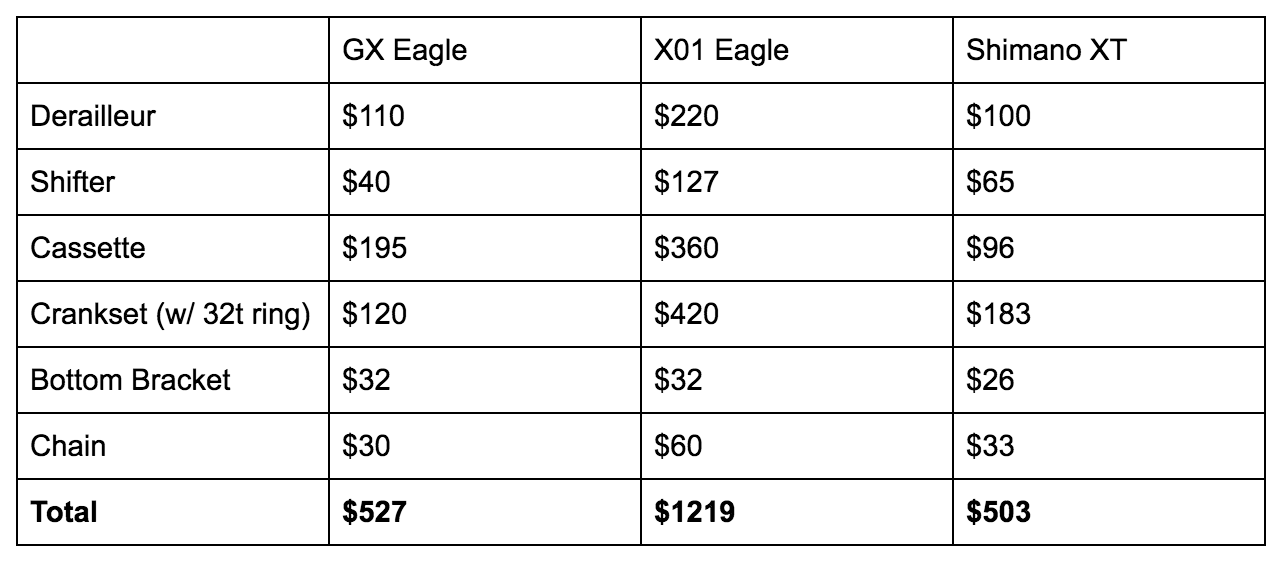
It’s also worth noting that, to use any of the Eagle drivetrains (or most of Sram’s 11-speed drivetrains), you’ll need an XD hub driver. If you’re running a Sram 11-speed drivetrain, chances are you already have an XD driver. If you’re not, you’d need to swap out the driver, which will likely cost somewhere in the neighborhood of $100, depending on the make of your hub.
NEXT: On-Trail Peformance — Pros and Cons

Nice review. I think that SRAM 11-speed 10/42 really hurt Shimano. They were awfully late to the party with their 11/46 cassette.
GX Eagle 12-speed 10/50 is going to eat their lunch.
This from a long-time Shimano fan (and still my preference for brakes).
What X01/GX combo would you do for a value/weight/noticable shifting?
From what you posted, I’d guess GX RD & chain, X01 shifter & cassette.
Hey Andy,
Yeah, I think that’s probably the combo I’d go for. The cassette is the big question – you save a bunch of weight, but it costs a fair amount more. If the budget was tight, I wouldn’t hesitate to stick with the GX Eagle cassette.
I’ve seen some comments the GX RD got some improvements over XX1 and X01, but not sure what, just like the XT Di2 over XTR. Can’t remember now what was it… so a GX RD/Chain + X01 Cassette/Shifter seems a great combo getting the best of both worlds.
Any issues with creaking yet? Almost everyone I know with a pinned SRAM mountain cassette eventually gets unfixable creaks as a few pins come loose enough to move around just a little.
Hey Noah, any issues with one-tooth skips on the especially 3 to 2 shift, and also occasionally on the 2 to 1?
My new XX1 is set up perfectly, but still has this issue on about one of every five shifts from 3 to 2. Seems related to the odd (to me) decision by SRAM to make the 2 and 1 cogs narrow wide. If the ramp grabs the wrong link, the chain ends up mis-timed by on tooth, and has to skip forward to get down onto the cog.
Thanks!
Hey Tom,
My shifts from 3 to 2 are fairly unproblematic, but I occasionally get a skip from 2 to 1. I’ve been attributing it more to the size of the cog rather than the narrow wide profile, but I could be wrong on that.
I think the reason for the n/w profile is to reduce chain drops while backpedaling, and at least in my experience, it works. With the 11 speed cassettes, in 1st gear I generally couldn’t backpedal more than 1/2 a rotation without dropping the chain. With the Eagle cassettes, I can backpedal indefinitely, even though the chainline is effectively worse.
But yeah, I think it’s a trade off. Backpedaling isn’t an issue, but the shifting is a little fussier. And I’d imagine that shifting in bumpy terrain where the chain is flopping around might exacerbate the problem, since there’s a better chance that the chain wouldn’t mesh in nicely with the narrow wide teeth.
Thanks for the quick reply, Noah. I’ve got about seven hours on the drivetrain now, and it has gotten a bit better. Honestly, I really question SRAM’s decision to address the back pedaling issue at the expense of regular shifting. Backwards priorities, IMO.
So a couple of things worth passing on:
1. Shifting today was better, perhaps because I followed a recommendation to thoroughly remove all the factory “lube” from the chain. Chain is noticeably more limber now.
2. It is clear to me and my LBS head mechanic that I got an Eagle XX1 derailleur with a nearly non-functioning clutch. About as much tension as an old clutchless XTR RD.
I’ll see the SRAM rep and discuss this later this week (he lives here in Hood River), so stay tuned, and thanks again.
Hey Tom,
That’s some good info. The only thing I’d add is that I’ve found that the b-screw adjustment is pretty crucial to getting good shifting (which wasn’t really the case on the 11 speed stuff), so make sure that’s dialed if you’re having shifting issues.
But as much as anything, I think it just comes down to a narrower chain and narrower spaces between cogs. That just means the margin for error is that much smaller, so the shift cable tension needs to be that much more precise. And if it’s even a tiny bit off, that’s usually going to manifest itself as an imperfect shift at one end of the shift range. Even something as simple as having the cable clamped in the derailleur slightly wrong can make a big enough difference to throw your shifting off. And I don’t mean to imply that your mechanic is screwing any of that up – just things to double and triple check.
I’m certainly a fan of the range that Eagle affords, and so far my shifting has been pretty decent, but as things wear out and the system gets a bit sloppier, I foresee those narrow tolerances becoming more of a liability. I’m interested to hear if you continue to run into issues.
Regarding the bent cage on the derailleur.
I have XX1 on my bike and it sucked in a stick/rough grass at one trail that caused pedal jam.
My bike also tipped over and fell once or twice that I’m not proud of :)
But there was no damage to the derailleur cage. It could be that the cage on XX1 is carbon and GX is aluminum. Carbon will return to form while aluminium will bend.
I’m also bit weary of a massive (and expensive) derailleur sticking out but in over 1200km I didn’t have issues.
While I was waiting for the shifter to arrive to my LBS, I used GX shifter and can’t fault it. Difference between the two is minimal and if you don’t absolutely have to have adjustable lever it’s good idea to go with the GX shifter.
XX1 cassette and chain are fantastic on the other hand. While they are structurally the same as X01, they have that gold hard wearing titanium nitride coating that’s holding up really well.
I don’t get why SRAM uses black coating that wears out quickly for X01/GX.
im surprised how durable eagle is. ive the xx1 version and 1.5year later i havent even changed the chain.. on my road bike i changed the force 22 chain about 6 times.. and the cassette 2 times.. and i dont think i ride it 6 times more.
Excellent review, Noah. Practical, thorough and realistic. You write like a guy who has to buy his own stuff and subsequently live with it. And, refreshingly, no hyperventilating over the rumored neutron-enhanced cryogenic 4-D printed graphene cassette that saves 50 grams for an extra $500. Kudos!
So I have a big problem with Blister’s bike reviews. That is cost. A full set of highly reviewed ski gear can be obtained for $2000. (Skis, boots, bindings). None of the bike gear reviewed here can be purchased in useable fashion for that price. Mountain Biking is pricing people out at an accelerating rate. Review some $1200 bikes and tell us what’s worth buying.